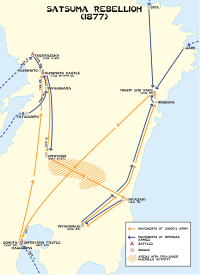Satsuma rebellion
| Satsuma Rebellion 西南戦争 |
|||||||
|---|---|---|---|---|---|---|---|
 Map of the campaign |
|||||||
|
|||||||
| Belligerents | |||||||
|
|
|
||||||
| Commanders and leaders | |||||||
|
Ruler: Meiji Emperor CIC: Prince Arisugawa Taruhito Kawamura Sumiyoshi Yamagata Aritomo |
Saigō Takamori † | ||||||
| Strength | |||||||
| 70,000 | 20,000 to 30,000 | ||||||
| Casualties and losses | |||||||
|
about 20,000 (either killed or surrendered) | ||||||
The Satsuma Rebellion (西南戦争 Seinan Sensō (Southwestern War)?) was a revolt of disaffected samurai against the new imperial government, nine years into the Meiji Era. Its name comes from Satsuma Domain, which had been influential in the Restoration and became home to unemployed samurai after military reforms rendered their status obsolete. The rebellion lasted from January 29, 1877, until September of that year, when it was decisively crushed and its leader, Saigō Takamori, ended his life.
Saigō's rebellion was the last and most serious of a series of armed uprisings against the new government.
Although Satsuma Domain had been one of the key players in the Meiji Restoration and the Boshin War, and although many men from Satsuma had risen to influential positions in the new Meiji government, there was growing dissatisfaction with the direction the country was taking. The modernization of the country meant the abolition of the privileged social status of the samurai class, and had undermined their financial position. The very rapid and massive changes to Japanese culture, language, dress and society appeared to many samurai to be a betrayal of the jōi ("expel the barbarian") portion of the sonnō jōi justification used to overthrow the former Tokugawa shogunate.
Saigō Takamori, one of the senior Satsuma leaders in the Meiji government who had supported the reforms in the beginning, was especially concerned about growing political corruption (the slogan of his rebel movement was shinsei-kōtoku (新政厚徳?, new government, high morality). Saigō was a strong proponent of war with Korea in the Seikanron debate of 1873. At one point, he offered to visit Korea in person and to provoke a casus belli by behaving in such an insulting manner that the Koreans would be forced to kill him. Saigō expected both that a war would ultimately be successful for Japan and also that the initial stages of it would offer a means by which the samurai whose cause he championed could find meaningful and beneficial death. When the plan was rejected, Saigō resigned from all of his government positions in protest and returned to his hometown of Kagoshima, as did many other Satsuma ex-samurai in the military and police forces.
...
Wikipedia
